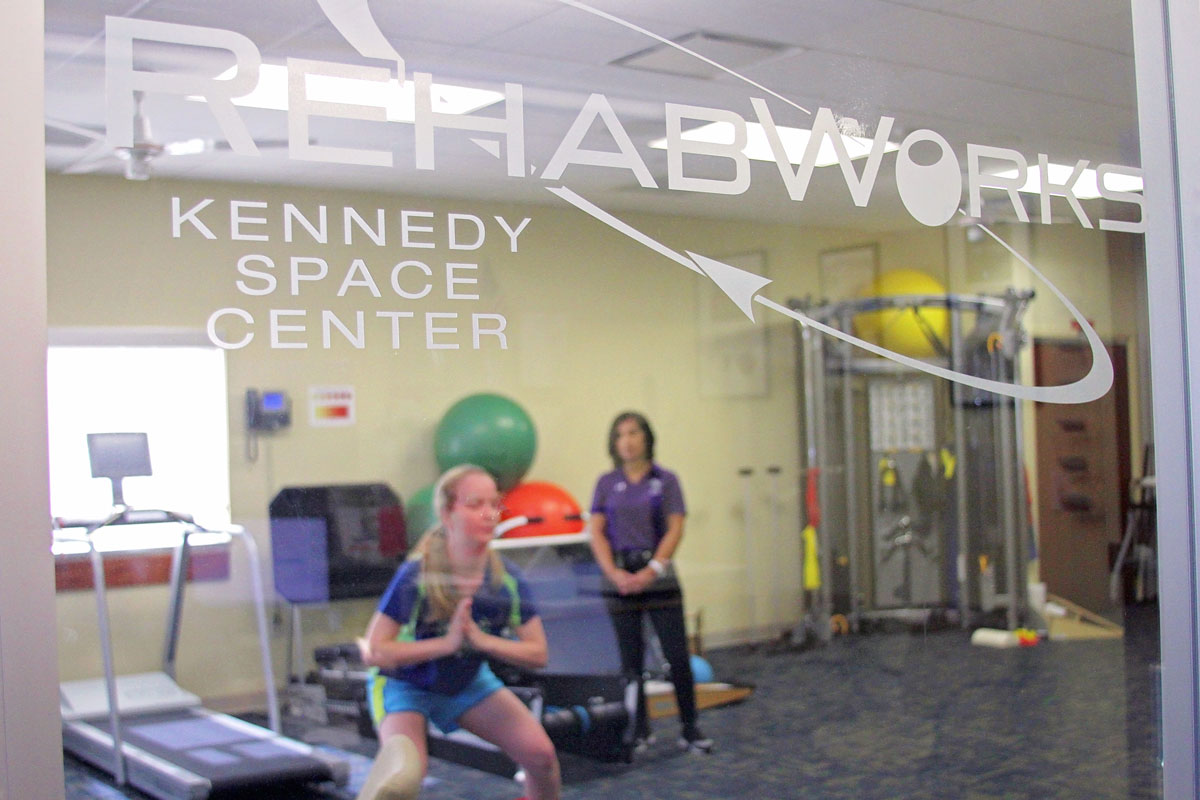Entering the double doors of the Neil Armstrong Operations and Checkout Building on NASA’s 144,000-acre property at Kennedy Space Center in Florida, Nicole Cardenas is immediately greeted by the NASA logo etched into the entrance’s tile floor.
Nearby, a model of the Orion spacecraft, which is designed for deep-space exploration, intrigues visitors. Not far away, the spacesuit Neil Armstrong wore in 1969 when he became the first man to walk on the moon and famously took a “giant leap for mankind” is on display and reminds guests of that historic moment.
This summer Cardenas, an SFA athletic training graduate student, made a giant leap of her own when she interned at RehabWorks, the athletic training clinic at NASA’s Kennedy Space Center.
“It was such an amazing opportunity,” Cardenas said. “I not only saw some of the space program’s historic treasures, like Neil Armstrong’s spacesuit, but I also heard stories from incredible people who all contribute to the space program and put so much time and effort into the future of space exploration.”
Landing the Internship
Cardenas has always desired to help people, and becoming an athletic trainer seemed like the perfect profession in which to achieve her goal.
After earning her bachelor’s degree, Cardenas visited SFA and fell in love with the beautiful campus. A deeper look into the graduate athletic training program convinced her to apply. The university’s two-year intensive program meshes academic and clinical work. Program faculty members strive to teach students that they should “dare to reach beyond their boundaries.”
“When I researched the program, I discovered a great opportunity — a university where I felt I could receive the education I was hoping to find, as well as a place that could open doors and help me figure out where I wanted to go in my career,” Cardenas said.
An internet search led Cardenas to the internship at NASA. After a discussion with Dr. Linda Bobo, director of SFA’s graduate athletic training program, the duo polished and submitted Cardenas’ résumé and waited for a response. She interviewed via Skype a few weeks later.
“I have followed NASA for the past couple of years, and I was gifted a telescope for Christmas last year, so I was almost speechless when I received the call that I was chosen to participate in the program,” Cardenas said.
According to Bobo, she was overjoyed to have an athletic training graduate student secure an internship with NASA.
“It was a personal and professional bucket-list goal of mine for a graduate student in our program to achieve this internship,” Bobo said. “NASA is a high-profile, nontraditional clinical setting. The clientele and work environment make it particularly unique for athletic trainers.”
Mary Kirkland, a licensed athletic trainer and athletic training supervisor for RehabWorks, started the clinic 21 years ago to promote free employee wellness and healthy living to all NASA employees, including astronauts, researchers and scientists.
Since its inception, the clinic has offered an internship program. According to Kirkland, more than 100 university students from across the nation have interned at the clinic. Each school is represented with its logo on a banner that hangs inside the facility. As the first Lumberjack to serve in the program, Cardenas is responsible for the addition of SFA’s logo.
Training at RehabWorks
Cardenas’ day began with a 20-minute commute to the Kennedy Space Center from Port Saint John. Each morning, she would drive by the fuel tank and rocket boosters on display at the visitor complex — a visual reminder that she was not in Nacogdoches anymore. After gaining clearance at the security checkpoint, she would make her way to the “O and C Building” to start prepping for the day’s patients.
As an intern, Cardenas worked daily with multiple patients. She conducted evaluations of musculoskeletal injuries, created rehab designs, closely interacted with clinicians, worked with a variety of therapeutic modalities, and completed daily charting and patient education.
She also helped the staff with a yoga class held at “Balance Zones” in various buildings at the space center. These zones are small areas where employees are encouraged to take a break and de-stress.
As a nontraditional clinical setting, Cardenas said the NASA facility helped diversify her training.
“Most athletic trainers work on the sidelines during sporting events and witness injuries when they occur,” Cardenas said. “However, the RehabWorks’ athletic trainers typically don’t witness the injuries happening. Therefore, we applied critical thinking and questioning to determine the issue’s source.”
Kirkland agrees the facility provides a unique opportunity for students to learn.
“You have to play sleuth and delve into the problem,” Kirkland said. “That’s one of the skills we teach the students. They really have to hone in on how to be a detective and question the patient and look at the issue from different angles to connect the dots.”
Throughout the summer, Cardenas worked closely with Kirkland and Ian Stites, intern coordinator and athletic trainer, which was the highlight of the internship.
“My most meaningful experience was learning from the excellent athletic trainers, each at a different point in their career,” Cardenas said. “They were all amazing and just great teachers to learn from. I am so lucky I got to be part of this amazing experience.”



